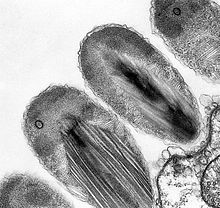Verrucomicrobia is a phylum of Gram-negative bacteria that contains only a few described species. The species identified have been isolated from fresh water, marine and soilenvironments and human faeces. A number of as-yet uncultivated species have been identified in association with eukaryotic hosts including extrusive explosive ectosymbiontsof protists and endosymbionts of nematodes residing in their gametes.[citation needed]
Verrucomicrobia are abundant within the environment, though relatively inactive.[1] This phylum is considered to have two sister phyla: Chlamydiae and Lentisphaerae within the PVC group.[2] The Verrucomicrobia phylum can be distinguished from neighbouring phyla within the PVC group by the presence of several conserved signature indels (CSIs).[3]These CSIs represent unique, synapomorphic characteristics that suggest common ancestry within Verrucomicrobia and an independent lineage amidst other bacteria.[4] CSIshave also been found that are shared by Verrucomicrobia and Chlamydiae exclusively of all other bacteria.[5] These CSIs provide evidence that Chlamydiae is the closest relative to Verrucomicrobia, and that they are more closely related to one another than to the Planctomycetales.
Verrucomicrobia might belong in the clade Planctobacteria in the larger clade Gracilicutes.[6]
In 2008, the whole genome of Methylacidiphilum infernorum (2.3 Mbp) was published. On the single circular chromosome, 2473 predicted proteins were found, 731 of which had no detectable homologs. These analyses also revealed many possible homologies with Proteobacteria.[7][8]
| Verrucomicrobia | |
|---|---|
 | |
| Transmission electron micrograph of stage II epixenosomes. |
https://en.wikipedia.org/wiki/Verrucomicrobia
above. psyclon nine - nothing left
No comments:
Post a Comment